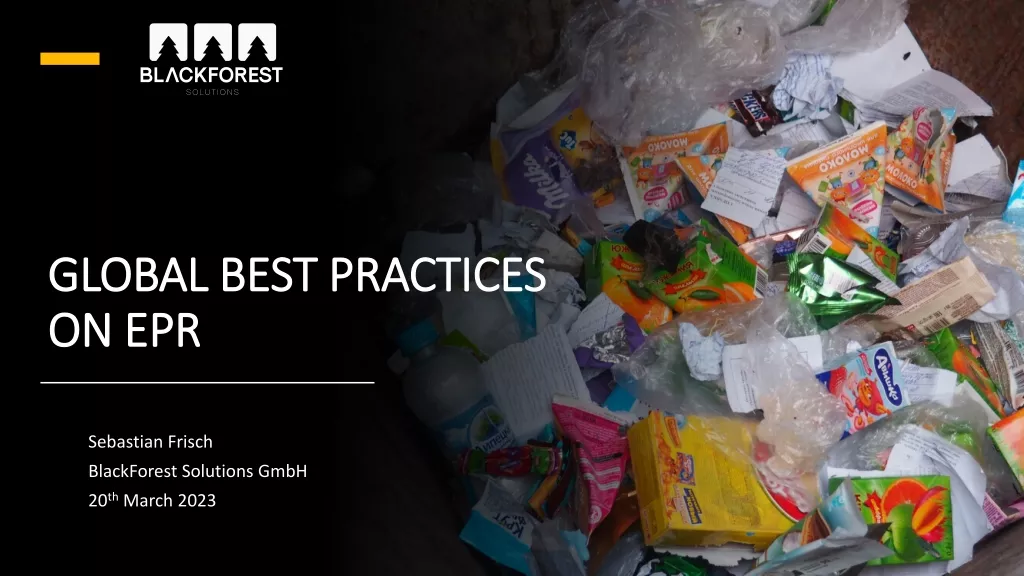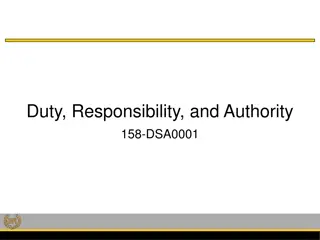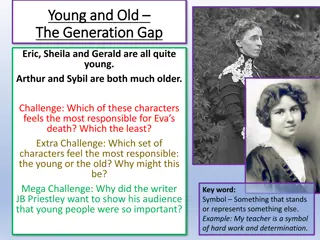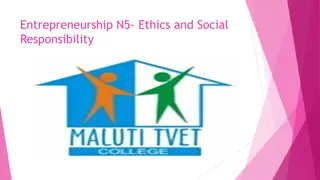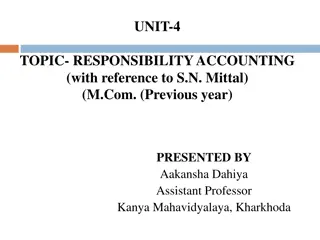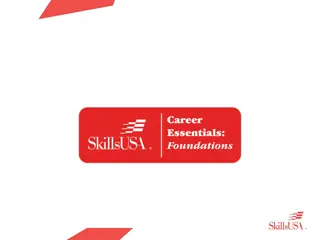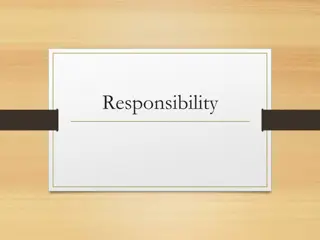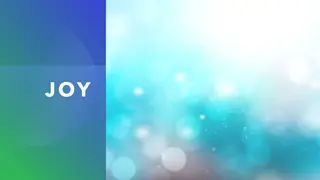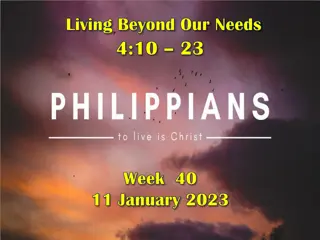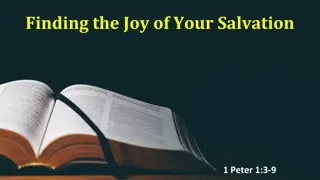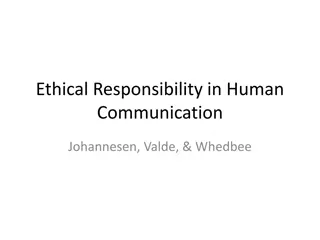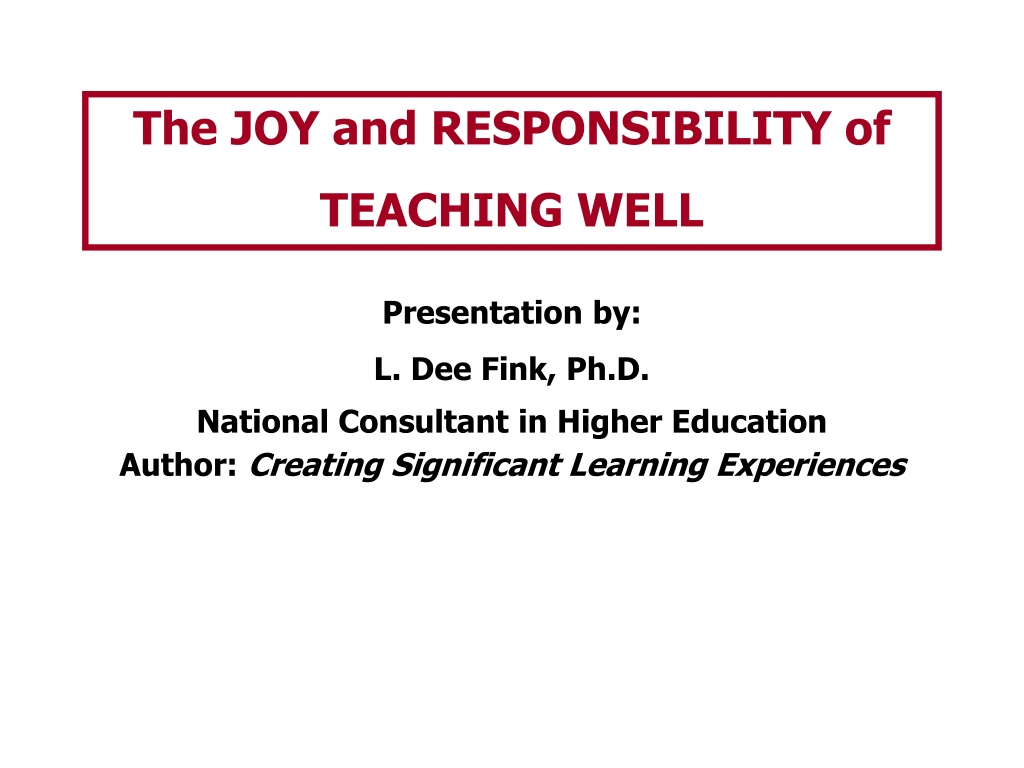
The Joy and Responsibility of Teaching Well
Discover the significance of teaching well in higher education through a presentation by L. Dee Fink, Ph.D. This content highlights the crucial role of educators in shaping students' learning experiences and preparing them for a knowledge-intensive, constantly evolving world. Insights from Derek Bok shed light on the challenges and areas needing improvement in undergraduate education, prompting a re-examination of what and how we teach, as well as how we prepare and who we are as educators.
Uploaded on | 0 Views
Download Presentation

Please find below an Image/Link to download the presentation.
The content on the website is provided AS IS for your information and personal use only. It may not be sold, licensed, or shared on other websites without obtaining consent from the author. If you encounter any issues during the download, it is possible that the publisher has removed the file from their server.
You are allowed to download the files provided on this website for personal or commercial use, subject to the condition that they are used lawfully. All files are the property of their respective owners.
The content on the website is provided AS IS for your information and personal use only. It may not be sold, licensed, or shared on other websites without obtaining consent from the author.
E N D
Presentation Transcript
The JOY and RESPONSIBILITY of TEACHING WELL Presentation by: L. Dee Fink, Ph.D. National Consultant in Higher Education Author: Creating Significant Learning Experiences
The Joy and Responsibility of Teaching Well Tertiary education [i.e., higher education] is more critical, the flatter the world gets. -Thomas Friedman, The World is Flat (p. 289) [The new world economy] is highly knowledge- intensive so you must be good at constantly learning. If you stand still, you fall back. -J.F. Rischard, High Noon (p. 30)
The Joy and Responsibility of Teaching Well Evidence That Students Are NOT Having Significant Learning Experiences: Employers Derek Bok: Our Underachieving Colleges
The Joy and Responsibility of Teaching Well Derek Bok: Learning to communicate Learning to think Building character Preparation for citizenship Living with diversity Preparing for a global society Acquiring broader interests Preparing for a career from: Our Underachieving Colleges: A Candid Look at How Much Students Learn and Why They Should Be Learning More (2006)
The Joy and Responsibility of Teaching Well Derek Bok: lack of any overarching purpose in the undergraduate curriculum. allowing intellectual standards to deteriorate. colleges and universities accomplish far less for their students than they should. from: Our Underachieving Colleges: A Candid Look at How Much Students Learn and Why They Should Be Learning More (2006)
The Joy and Responsibility of Teaching Well Issues We Need to Re-Examine I. WHAT We Teach II. HOW We Teach III. How We GEAR UP to Teach IV. WHO We Are
The Joy and Responsibility of Teaching Well Issues We Need to Re-Examine WHAT We Teach HOW We Teach How We GEAR UP WHO We Are
The Joy and Responsibility of Teaching Well Issues We Need to Re-Examine WHAT We Teach HOW We Teach How We GEAR UP WHO We Are
The Joy and Responsibility of Teaching Well Issues We Need to Re-Examine I. WHAT We Teach = What we want students to learn Now: Primarily Knowledge about our discipline Need? Something more significant.
Taxonomy of Significant Learning Learning How to Learn Becoming a better student Inquiring about a subject Self-directing learners Foundational Knowledge Understanding and remembering: Information Ideas Application Skills Thinking: Critical, Creative, & Practical Managing projects Caring Developing new Feelings Interests Values Integration Connecting: Ideas People Realms of life Human Dimensions Learning about: Oneself Others
The Joy and Responsibility of Teaching Well In a course with significant learning, students will: 1. Understand and remember the key concepts, terms, relationship, etc. 2. Know how to use the content. 3. Be able to relate this subject to other subjects. 4. Understand the personal and social implications of knowing about this subject. 5. Value this subject and further learning about it. 6. Know how to keep on learning about this subject, after the course is over.
The Joy and Responsibility of Teaching Well Issues We Need to Re-Examine WHAT We Teach HOW We Teach How We GEAR UP WHO We Are
The Joy and Responsibility of Teaching Well Issues We Need to Re-Examine WHAT We Teach HOW We Teach How We GEAR UP WHO We Are
The Joy and Responsibility of Teaching Well II. HOW We Teach Now: Primarily Lecture/textbook/homework, plus: whole class discussion lab Need? More powerful kinds of learning require more powerful kinds of teaching.
The Joy and Responsibility of Teaching Well FUNDAMENTAL TASKS OF TEACHING Knowledge of the Subject Matter Interacting with Students Designing Learning Experiences Managing the Course Beginning of the Course
INTEGRATED COURSE DESIGN: Key Components Learning Goals Teaching & Learning Activities Feedback & Assessment S i t u a t i o n a l F a c t o r s
Criteria of GOOD Course Design Significant Learning Learning Goals Teaching Strategy Teaching and Learning Activities Feedback & Assessment Active Learning Educative Assessment S I T U A T I O N A L F A C T O R S In-Depth Situational Analysis
Criteria of GOOD Course Design Significant Learning Learning Goals Teaching Strategy Teaching and Learning Activities Feedback & Assessment Active Learning Educative Assessment S I T U A T I O N A L F A C T O R S In-Depth Situational Analysis
The Joy and Responsibility of Teaching Well In a course with significant learning, students will: 1. Understand and remember the key concepts, terms, relationship, etc. 2. Know how to use the content. 3. Be able to relate this subject to other subjects. 4. Understand the personal and social implications of knowing about this subject. 5. Value this subject and further learning about it. 6. Know how to keep on learning about this subject, after the course is over.
Criteria of GOOD Course Design Significant Learning Learning Goals Teaching Strategy Teaching and Learning Activities Feedback & Assessment Active Learning Educative Assessment S I T U A T I O N A L F A C T O R S In-Depth Situational Analysis
Holistic Active Learning Experience Doing, Observing Actual, Simulated Rich Learning Experiences Reflection About the Subject Learning Process Via: Journaling, Learning Portfolios Information & Ideas Primary/Secondary In-class, out-of-class, online
Multiple Activities that Promote ACTIVE LEARNING EXPERIENCE REFLECTIVE DIALOGUE, with: Self Reflective thinking GETTING INFORMATION & IDEAS "Doing" Real Doing, in authentic settings "Observing" Direct observation of phenomena Others Live dialogue Original data DIRECT (in or out of class) Original sources Journaling Case studies Gaming, Simulations Role play Secondary data and sources Stories (can be accessed via: film, literature, oral history) INDIRECT, VICARIOUS Lectures, textbooks Course website Teacher can assign students to "directly experience" Students can engage in "indirect" kinds of experience online Students can reflect, and then engage in various kinds of dialogue online. ONLINE Internet
Criteria of GOOD Course Design Significant Learning Learning Goals Teaching Strategy Teaching and Learning Activities Feedback & Assessment Active Learning Educative Assessment S I T U A T I O N A L F A C T O R S In-Depth Situational Analysis
Feedback and Assessment: EDUCATIVE ASSESSMENT Forward-Looking Assessment Self-Assessment Criteria and Standards FIDeLity Feedback
Feedback and Assessment: EDUCATIVE ASSESSMENT Forward-Looking Assessment Task Criteria and Standards Self-Assessment Feedback
Criteria of GOOD Course Design Significant Learning Learning Goals Teaching Strategy Teaching and Learning Activities Feedback & Assessment Active Learning Educative Assessment S I T U A T I O N A L F A C T O R S In-Depth Situational Analysis
The Joy and Responsibility of Teaching Well TEACHING STRATEGY: A particular COMBINATION of learning activities arranged in a particular SEQUENCE Two Examples: Problem-based learning Team-based learning
The Joy and Responsibility of Teaching Well CASTLE-TOP DIAGRAM: A Tool for Identifying Your TEACHINGSTRATEGY Mon Wed Fri ? ? Mon Wed Fri Assessm t & Feedback In-Class Activities: Out-of- Class Activities: ? ?
TEACHING STRATEGIES In- class: Out- of- class: Lecture Lecture Lecture Exam Read text Homework exercises Review QUESTION: This strategy creates a high likelihood that most students will 1. Be exposed to the content. 2. Understand the content. 3. Be able to use the content. 4. Value the content.
TEACHING STRATEGIES In- class: Readiness Assurance Test: Individual Group Application problems (Small Groups) Exam: Content Application Culminating Project Out- of- class: Read text Homework exercises Review QUESTION: This strategy creates a high likelihood that most students will Be exposed to the content. Understand the content. Be able to use the content. Value the content.
FUNDAMENTAL TASKS OF TEACHING Knowledge of the Subject Matter Interacting with Students Designing Learning Experiences Managing the Course Beginning of the Course
Issues We Need to Re-Examine WHAT We Teach HOW We Teach How We GEAR UP WHO We Are
Issues We Need to Re-Examine WHAT We Teach HOW We Teach How We GEAR UP WHO We Are
The Joy and Responsibility of Teaching Well III. How We GEAR UP to Teach Now: Primarily Increase our knowledge of our discipline. Need? Teaching in a more powerful way, requires MORE TIME LEARNING new ideas about teaching and learning.
The Joy and Responsibility of Teaching Well Getting Better Over Time Everyone s Potential A Quality of Teaching B (now) Time
The Learning Cycle: 3 WAYS OF LEARNING Ideas/Literature on COLLEGE TEACHING 2 3 COLLEAGUES LEARN REFLECT SHARE 1 USE ASSESS
1991 - 1995 1991 ACTIVE LEARNING 1991 COOPERATIVE LEARNING 1992 LEARNING STYLES 1993 CLASSROOM ASSESSMENT TECHNIQUES 1995 CRITICALLY REFLECTING ON YOUR OWN TEACHING 1995 EVALUATING YOUR OWN TEACHING 1995 EMOTIONAL INTELLIGENCE
1996 - 2000 1996 TEACHING STUDENTS HOW TO ENGAGE IDEAS 1997 TEACHING PORTFOLIO 1997 DEEP LEARNING 1998 EFFECTIVE GRADING RUBRICS 1998 IN-DEPTH UNDERSTANDING OF ONESELF AS A PERSON/TEACHER
1996 2000 (cont.) 1998 SERVICE LEARNING 1998 STRUCTURED ASSIGNMENTS FOR SMALL GROUPS 1999 PEER REVIEW OF TEACHING 1999 LEARNING COMMUNITIES
2001 2004 2001 - PROBLEM-BASED LEARNING 2002 HOW THE BRAIN WORKS 2002 LEARNER-CENTERED TEACHING 2003 A TAXONOMY OF SIGNIFICANT LEARNING 2003 INTEGRATED COURSE DESIGN
2001 2004 (cont.) 2004 THEORIES OF LEARNING AND MOTIVATION 2004 TEAM-BASED LEARNING 2004 LEARNING PORTFOLIOS 2004 INQUIRY-GUIDED LEARNING 2004 FORMATIVE FEEDBACK 2004 WHAT THE BEST COLLEGE TEACHERS DO
2005 - 2006 2005 TEACHING INCLUSIVELY 2005 LEADING DISCUSSIONS 2005 FINDING JOY IN TEACHING 2006 CONSTRUCTING COLLEGE COURSES 2006 SKILLFUL TEACHING
The Learning Cycle: 3 WAYS OF LEARNING Ideas/Literature on COLLEGE TEACHING 2 3 COLLEAGUES LEARN REFLECT SHARE 1 USE ASSESS
The Joy and Responsibility of Teaching Well RATE of Improvement from: DIFFERENT WAYS of Learning About Teaching 1 + 2 + 3: Ideas from Literature on College Teaching Quality of Teaching 1 + 2: Learning from Others 1: Only from Own Experience (now) Time
The Joy and Responsibility of Teaching Well Issues We Need to Re-Examine WHAT We Teach HOW We Teach How We GEAR UP WHO We Are
The Joy and Responsibility of Teaching Well Issues We Need to Re-Examine WHAT We Teach HOW We Teach How We GEAR UP WHO We Are
The Joy and Responsibility of Teaching Well FACULTY MEMBERS: Who Are We? What Qualities Do We Value? 1. NOW: We primarily see ourselves as.. SUBJECT MATTER SPECIALISTS 2. NEED? We need to also see ourselves as PROFESSIONAL EDUCATORS All professionals value their own Professional Development very seriously.
The Joy and Responsibility of Teaching Well FACULTY as PROFESSIONAL EDUCATORS: What would that mean? That faculty members, as college teachers, will: 1. Be familiar with the literature on college teaching, 2. Use the ideas of best practice in their own teaching, and 3. Engage in continuous improvement regarding current ideas on teaching and their teaching.

